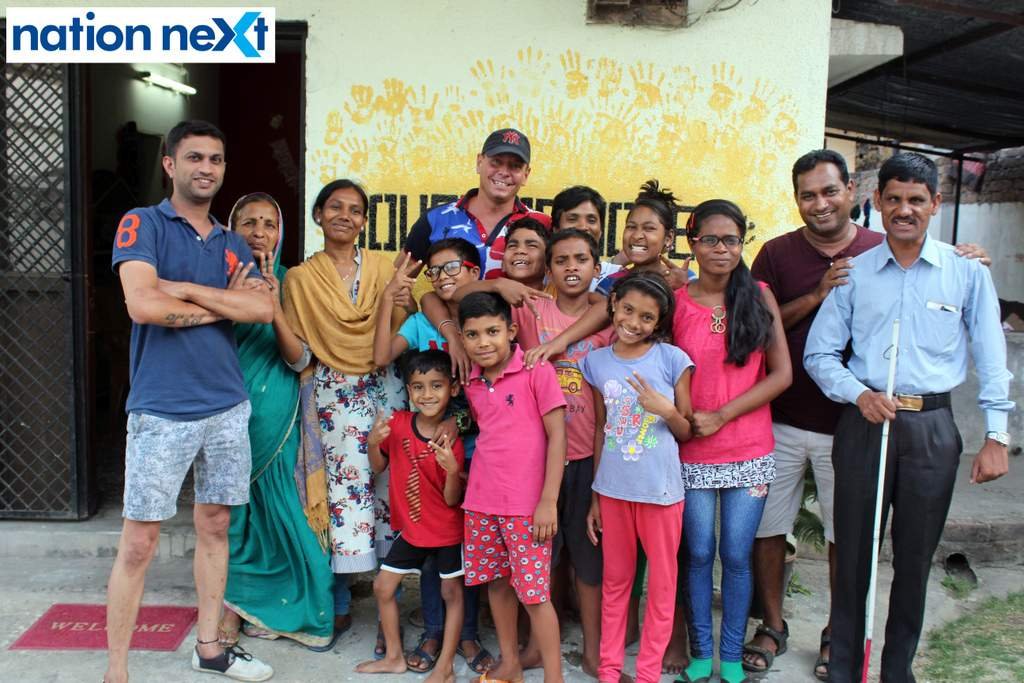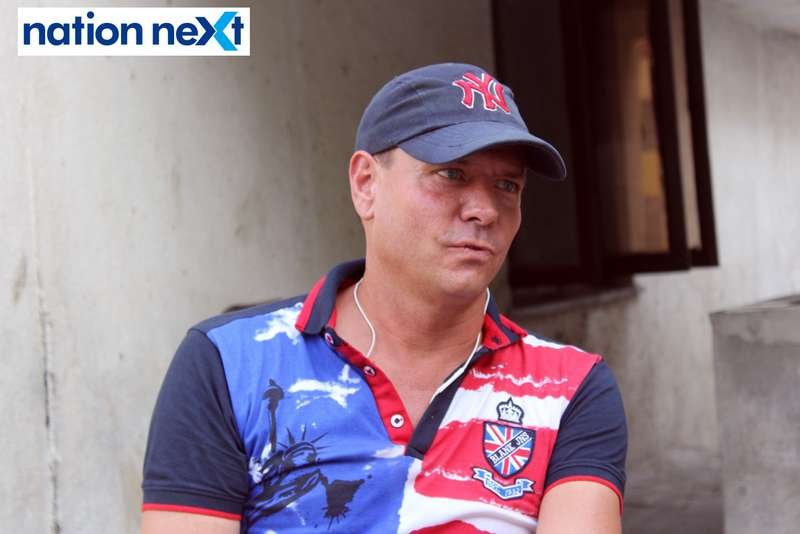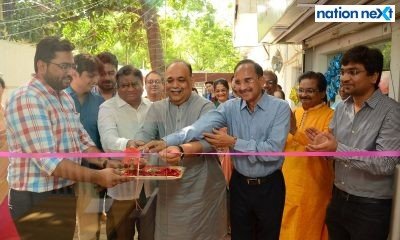People
Meet the American who runs the ‘House of Hope’ for HIV affected kids in Nagpur

Jerry Hughes, an American citizen, was diagnosed with HIV in 2004. Jerry, who was working as an advertising professional in the United States of America, chose not to get bogged down and took the control of his life in his own hands. By his own confession, the American, who would visit Nagpur often for speaking at youth camps, fell in love with Nagpur on his very first visit to the city. On a mission to eradicate the stigma related to HIV and AIDS and help affected people, Jerry founded the Hughes Foundation in Nagpur, which also has its presence in the US and Africa. One and half years back, Jerry founded the House of Hope in Nagpur. The house, today, is home to orphans suffering from HIV. In an exclusive interview with Nation Next, Jerry Hughes speaks about his own fight with HIV, his work through Hughes Foundation and the House of Hope and the stigma prevalent in the society relating to HIV and AIDS. Excerpts:
House of Hope? is home to kids suffering from HIV. Tell us more about it?
Before setting up House of Hope, through Hughes foundation, we would focus on partnerships with other orphanages and work at places where HIV organisations worked, but I felt a certain lack of satisfaction. So, I started House of Hope, which provides shelter to kids suffering from HIV. We also take care of their schooling, different recreational classes and other necessities of their life. The basic difference between House of Hope and any other organisation is that each and every person here is affected with HIV in some or the other way. These people can discuss and talk freely with each other as they share the same problems.
You yourself are HIV positive. What health-related problems do HIV patients go through? How does it affect a person emotionally?
For me personally, I’ve had no physical problems because I have always received proper treatment. When a person accepts the fact that he/she has HIV and takes the proper treatment, the person can live a very normal long-term life. If somebody has HIV and they don’t know what HIV means and fail to take medical treatment, they can face a lot of physical and health related problems like cancers and tumors. For me, HIV has affected me more emotionally than physically. After the detection of the disease, my family members distanced themselves from me, which caused me a lot of emotional stress.
People usually perceive HIV and AIDS to be the same thing?
I’ve never had AIDS. I was diagnosed with HIV. There are a lot of immunity related problems a person with HIV goes through. If one does not get proper treatment, they can have AIDS. Having AIDS means that a person has a very weak immune system and his/her inner body is substantially damaged because of the disease.

What kind of discrimination do people suffering from HIV face from society?
Due to lack of awareness, people usually treat HIV patients in a discriminating way. They don’t interact with patients thinking that they may get infected by the disease themselves, which is certainly not the case. The actual problem is the stigma prevalent in the society. Money, social status and many other factors also play an important role in the way people treat those suffering from HIV. If your financial status is good, you have a job and a proper medical treatment, people will treat you the same way as someone who does not have HIV. But if you are poor, people might treat you differently. I’ve never faced such treatment from the society and neither any of my kids from House of Hope as we always managed to give them proper treatment. Different stories of people dying and getting cancer is the main cause that creates stigma among people and fear of HIV. Also, most people have never met someone talking positive about HIV.
What according to you should be done to spread awareness among people about HIV and AIDS?
There are two ways through which we can spread awareness about HIV. Firstly, we can support the people diagnosed with HIV and ensure that they live a normal public life. There are 42 million people in the world who are living with HIV and India ranks third with most number of AIDS and HIV patients. If we can talk to them and help them feel normal about their problem, we can prevent the spread of HIV.
You run a fun and informative video series HF Scooter Cam? on YouTube. Tell us something about it.
Scooter Cam is a fun project wherein we ask common people the usual questions that arrive in our minds when we think of HIV. As part of the Scooter Cam? series, we, in the past, have asked Nagpurians questions like – Can a mosquito bite cause HIV? The idea is to break the ice by making everybody relaxed and then talk about HIV. I started it to prevent HIV being perceived as so scary.
Also, I feel, being a foreigner, talking to people here about HIV is a bit easy for me as people readily accept the things I say. If I may have been an Indian affected with HIV, I might have got pushed away by the people. My identity as a foreigner changes the way people think of people living with HIV. As a foreigner, I think, a foreigner gets more attention from people in India, which I find very interesting.
There are several countries that put a ban on HIV and even deport citizens infected with HIV?
In a developed country like America, people with HIV could not freely move around cities till 2009. But President Obama then lifted the ban, which was enacted in 1987. People forget that even America was one of those countries with a ban on people with HIV traveling to their country. Even I was stopped from entering some countries, while traveling.
Having said that, I think, things are changing now. But some misconceptions and laws are still there, which keep reminding me that that the country I belong from also bans people diagnosed with HIV. It’s of course not right but I think fighting with it in a positive manner matters more. Instead of wars, fighting, screaming or hurting people, my way of reforming the world is through creating more units of House of Hope? and foundations to support people with HIV.
What changes have you brought through Hughes foundation? How do you manage to get funds for the same?
The biggest change that Hughes Foundation has brought is that it has been successful in creating a positive influence among people whether they are living in India, South Africa or America. I think the biggest change that can be brought whether you are living with HIV or not is that everybody can learn something with the help of the bad things, which have happened taken place in their lives. We all go through hard times but if someone can get inspired through my story or the children at House of Hope, it would be great.
The funds we get for Hughes Foundation or House of Hope are 100% from the donations. There is no government or business funding. Our way of communicating with people is through social media.
For the future, we plan to create many more units of House of Hope. We are already in the process of creating the 2nd House of Hope. Our focus will be on kids who have abandoned because they suffer from HIV and on adults, who are struggling to find a job.
You have lived with HIV for 14 years now. How did HIV change your perspective towards life?
When I was diagnosed with HIV, it gave me a sense of purpose in life. It gave me the strength to do something different rather than being buried with negative questions in my head. My message to everybody would be to take something bad in life and turn it into good by creating a purpose out of it.
People
London student leaves Mumbai to reach Nagpur in tempo mini bus; shares her bittersweet experience | COVID-19

Nagpur girl Aditi Soni, who is a student of Service Design at Royal College of Arts in London, shares her recent experience of travel from London to her hometown Nagpur via Mumbai. Aditi, who reached Nagpur few days back in a tempo and is currently quarantined at a city hotel, narrates her experience of traveling in COVID-19 lockdown and what makes it a bittersweet memory for her.
Read what Aditi has to say about her experience?
I write today on my journey back home to India as an evacuee and what one should expect in an evacuation during these unprecedented times of COVID-19.
As a service design student in London, a lot of my learning is system centric, aiming at making inclusive, human friendly flows and that is what made me experience this journey in various packets of emotions. Having said that, what follows next must be taken with a pinch of salt. I’ve always believed in the mantra that credit must be given where it is due, but also that a spade must be called a spade.
At the outset it is important to set the record straight that the officials behind this operation must be lauded for taking on the mammoth challenge of helping several thousands of Indians stranded overseas get back home. As much as I am thankful to have made it back, the entire process did come with its fair share of troubles.
As with most registrations, my journey too began with the monotonous process of filling out forms with the Indian High Commission in London. The unexpected call came on the evening of 12th May and brought with it equal proportions of joy and anxiety. I was to fly out the very next day! While my mind tried to accept this last-minute departure, I was horrified to realise that this journey would burn a deep dark hole in my pocket!
Overnight packing and last-minute housekeeping consumed most of my evening. The next morning, my groggy eyes peered out of the cab only to spot empty streets of London and my heart yearned for this new normal? to end. Unlike its counter part in India, Heathrow Airport seemed adequately prepared to handle the passengers.

We stood in serpentine queues to finish the immigration process, all the while strictly following social distancing norms. Special shout out to the on-ground staff at Heathrow that patiently helped not only the old, but also young anxiety filled travellers with their incessant queries. One should be weary of the fact that they’re put on a flight as per availability and not as their your choice; sleep deprivation can be taxing especially for the old, so it is advisable that you should embark on this mission with strong will power.
They say animals live in herds for protection; maybe this analogy applies to us humans as well. As we sat to be airlifted in the waiting area to reach Nagpur, it was evident that people were crowding, despite the airport being largely empty. Maybe it was fear or the sense of familiarity that brought people closer, but it was pretty evident that all norms of social distancing were being blatantly flouted.
Money can buy luxury and give priority. The first and business class passengers were ushered in first, the elderly were made to wait for their turn. After all what can an economy passenger expect, rightAs I entered the flight, my hopes were dashed ? there was no social distancing being practiced whatsoever. I thanked my stars that I had got an aisle seat. Upon that sight, I pondered on what was more important in this situation ? taking more people back home or taking a select few on a first come first serve basis Obviously former seemed like the more prudent thing to do.

Once boarding was complete, the PPE adorned Air India crew trotted around and our seats already had the protection gear and food. Just as the airplane started touching the runway, a big cheer engulfed the atmosphere.
I woke up with a jolt just as the plane thundered down the runway at Chhatrapati Shivaji International Airport, Mumbai. With a sigh of relief and moments later, the off boarding of passengers had begun in a slow yet steady manner. After a while, it was finally my turn and an empty airport welcomed me. Thankfully, my screening process went through seamlessly, that might also be because I had made it a point to keep all documents ready and handy at all times.

Walking out of the airport I breathed a sigh of relief and expected the journey to Nagpur to be a cakewalk. Little did I know that the worst was yet to come. We were expecting to be on the bus en route Nagpur the moment we were out of the airport, but the lack of organisation led to an inevitable delay. There was a wait for around four hours, and these were tough hours due to lack of food and the unending wait for other passengers. Unfortunately, without a heads-up, we were asked to pay through our nose for the tempo bus service and with no option left, we paid them whatever they asked us for!
Once the twenty-hour journey started, it was pretty much the same throughout. Scorching heat, sweat, lack of food supplies and water, closed dhabas were the sights and highlights of this journey. My group was pretty enthusiastic and friendly so there was a support but the journey in itself was extremely long, yet worth it. What it lacked was maybe a bit of care vis-à-vis passengers with longer journeys; some protection or point of contact in case things went wrong.
Also read: India: Domestic flights to resume in calibrated manner from May 25
Upon our arrival in the city, as expected we were asked to quarantine ourselves at designated hotels for 14 days. We were quickly moved into the facility of our choice and that is when the journey ended.
A few pointers to make this process smoother for the upcoming passengers-
Firstly, giving enough heads-up for people travelling from places beyond the airport location. Second, making sure there is extra support and priority given to people with disabilities aged beyond 55-60 years. A rough travel estimate for the passengers could be helpful so they aren’t caught off-guard and can start arranging the money they need. Above all, taking care of the most sensitive elements ? their wellbeing, anxiety, providing assurance or supporting them even in their quarantine days with kindness.
Because at the end of the day, home is where the heart is”
People
Nagpur rural: Liquor lovers maintain social distancing while queuing up outside wine shops since 9 am
In what could be seen as a pleasant surprise so far, Nagpur residents in rural areas could be seen maintaining social distancing as they queued up outside wine shops to fetch liquor since 9 am.



People
Chef Vishnu Manohar prepares 1400 kg sabudana khichdi for Sai Baba devotees in Nagpur

Nagpur’s popular chef and owner of famous Vishnuji Ki Rasoi Vishnu Manohar prepared 1400 kg Sabudana Khichdi for Sai Baba devotees a program on Thursday. The programme was organised by Sri Sai Bhakt Sai Sevak Parivar Vidarbha? and Sai Palkhi Parivar Vidarbha, behind Sai Baba Temple at Wardha Road, for all Sai Baba devotees. Around 20, 000 people attended the programme and sought blessings of the saint.

The above two organising groups brought the original Paduka of Sai Baba from Shirdi and today after all the rituals left for Shirdi with the Paduka. The devotees would reach Shirdi on the coming Ram Navmi. During the event, Nagpur Mayor Sandip Joshi and former Guardian Minister of Nagpur Chandrashekhar Bawankule were also seen relishing the taste of Sabudana Khichdi.
Speaking to Nation Next, Vishnu Manohar said, I had fun preparing the Sabudana Khichdi today. Honestly, it was comparatively easy to prepare it because similarly I’d prepared 3,000 and 5,000 kgs of khichdi in the past. But yes, for sabudana khichdi we had to ensure the sabudana was soaked perfectly. Initially, we were supposed to make 1100 kgs of khichdi but because of the increase in the weight of soaked sabudana, the khichdi then rose to 1400kgs.
Also read: Nagpur ranks 1st in Maharashtra, 2nd in India as smart city; becomes greenest, safest in state
-

 Social4 years ago
Social4 years agoPoliticians, businessmen shower blessings on Chandrashekhar Bawankule’s son Sanket at his wedding reception
-
Health5 years ago
Amphoterecin B, used for treating black fungus, to now be manufactured in Nagpur
-

 Social4 years ago
Social4 years agoNagpur gets its first 7 am cafe ‘SEVEN O’ ELEVEN’ at Shraddhanand Peth
-

 Parties4 years ago
Parties4 years agoCouples have a blast, win awards at ‘Hollywood Oscar Night’ in Nagpur
-
Who´s Partying Next To You9 years ago
Nagpur brings in 2017 in style at Gondwana Club
-

 Parties4 years ago
Parties4 years agoFamily, friends ‘wine n dine’ at Dr Shilpa Mukherji’s birthday bash in Nagpur
-
Who´s Partying Next To You8 years ago
Party revelers make noise at Nagpur’s first silent party on New Year Eve at Gondwana Club
-

 Social4 years ago
Social4 years agoSunil Kedar kicks off 10-day Late Dr Shrikant Jichkar Memorial Cricket Tournament in Nagpur








